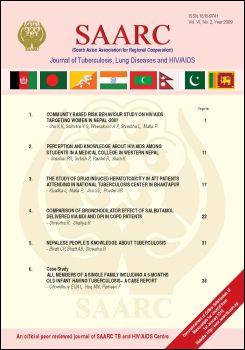The Study of Drug Induced Hepatotoxicity in ATT Patients attending in National Tuberculosis Center in Bhaktapur
DOI:
https://doi.org/10.3126/saarctb.v6i2.3053Keywords:
ATT patient, Rifampicin, Ethambutol, Hepatotoxicity, AST, ALT, EnzymesAbstract
The drug-induced hepatotoxicity is a significantly increasing problem worldwide, but it is of more concern in the treatment of tuberculosis (TB) infection, especially in a third world country like Nepal, where tuberculosis is still endemic. Liver has a central role in drug metabolism and detoxification, and is consequently vulnerable to toxic effects of the drugs. The study was carried out from August 2006 to May 2007. The ATT patients, who visited the chest clinic, were sent to the laboratory for analysis of Liver enzymes (ALT, AST) and bilirubin level. During the period of August 2006 to May 2007 total of 114 patients; 114 blood samples were collected for liver enzymes analysis. It was found that among114 ATT patients; 41 patients (35.0%) had abnormal parameters with the elevation of serum bilirubin level, AST level and ALT level. It showed that drug induced hepatotoxicity due to anti TB drugs is relatively higher rate among lower socio-economic status group. Out of 114 cases, the marked elevation of total bilirubin level (>5.0mg/dl) was found in 15 (13.0%) and mild elevation of bilirubin level (1.1-5.0mg/dl) was found in 25 (22.0%) patients while 74 (65.0%) patients were found to have normal level of bilirubin. Similarly, 17 (15.0%) patients were found to have moderate elevation of ALT level (above 51.0IU/L), 5 (4.0%) patients were found to have slight elevation of ALT level (36-50IU/L) and 92(81.0%) patients had normal level. Likewise 10 (9.0%) patients were found to have moderate elevation of AST level (above 51.0IU/L); 8 (7.0%) had slight elevation of AST level (41-50 IU/L); and 96 (84.0%) were found to have normal level. The facts associated behind these findings are probably poverty, malnourishment, alcohol consumption, illiteracy of people and poor health management system. Hence, for the treatment of TB, with ATT regimens, a baseline laboratory testing and monitoring system should be adopted before starting treatment which might help to reduce drug induced hepatotoxicity in ATT patients.
Keywords : ATT patient; Rifampicin; Ethambutol; Hepatotoxicity; AST; ALT; Enzymes.
DOI: 10.3126/saarctb.v6i2.3053
SAARC J. Tuber. Lung Dis. HIV/AIDS 2009 VI (2) 17-21
Downloads
Downloads
How to Cite
Issue
Section
License
Copyright © SAARC Tuberculosis and HIV/AIDS Centre (STAC), all rights reserved, no part of this publication may be reproduced, stored in a retrieval system or transmitted in any form or by any means without prior permission of the STAC.




